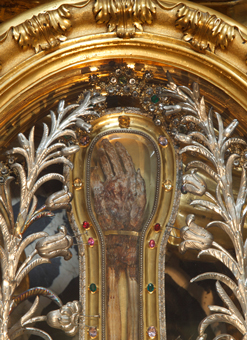by Carol Glatz

VATICAN CITY (CNS) – A saint’s lock of hair, bone shards, a vial of blood, even a severed hand whose discolored fingers curl in a macabre way are venerated by many members of the Catholic Church.
Others may just get the heebie-jeebies and wonder why holy people’s body parts are even put on display.
But if one believes these men and women lived holy lives and accomplished extraordinary things, “wouldn’t you want a souvenir,” a way to connect and remember that person and what they’ve done, said Elizabeth Lev, an art historian and professor of art history at the Rome campuses of Duquesne University and the University of St. Thomas in St. Paul, Minn.
The relic becomes a concrete reminder that the blessed or saint’s body is here on earth and his or her soul is with God, she said.
“It feels like you’ve got almost like a hotline into heaven,” she said. The relic is “something we can see and touch, and it becomes our portal to a world we cannot see and cannot touch.”
In the Catholic Church, relics fall into one of three categories: a first-class relic is the physical bodily remains of a saint or blessed, like bones, blood and hair; a second-class relic is a personal possession, such as clothing, devotional objects, handwritten letters or even furniture; and a third-class relic is an object that has touched a first-class relic. These – usually small snips of cloth that have touched a blessed or saint’s tomb – often end up in public distribution fixed onto prayer cards.
In early Christian times, small holes were often made to run vertically down into a saint’s tomb or even straight into the sarcophagus so that devotional items could be lowered onto the tomb’s surface or come in contact with the relics of the saint.
Creating such third-class relics became very popular in the late fourth-century in Rome after Emperor Theodosius banned the sale and distribution of corporal relics.
The sale of any relic is staunchly prohibited in the church. EBay has banned the sale of body parts, and church officials have called the sale of relics on the Internet sacrilege.
Nonetheless, demand for relics, mostly third-class relics, of Pope John Paul skyrocketed after it became clear that he was on the fast track to sainthood. The promoters of his cause, which were giving out third-class relics for free, had to publically state repeatedly that relics are never for sale.
No Special or Magical Powers
A relic has no special or magical powers, Lev said. It would be a mistake to believe any object, even a holy object, can be a sort of “remote control” to make God do one’s bidding or fulfill some heartfelt wish.
It’s true some saints, objects, shrines and icons seem “more efficacious” than others in connecting people to God, Lev said. But it’s not the object or the site bringing grace or a miracle; it is only a channel, an instrument through which God chooses to act.
“God controls what he’s going to do and how he’s going to do it,” she said.
Even in the modern secularized West, tours of saints’ relics have been enormously popular.
More than a quarter of a million people turned out to see the relics of St. Therese of Lisieux when her remains toured cities and villages throughout predominantly Anglican England and Wales in 2009. Massive crowds also flocked to see her remains during a U.S. tour in 1999, surprising even the event planners.
The huge turnouts sparked curiosity in the secular media and questions about why relics would attract so many people, including nonbelievers.
Lev said an over-secularized world that rejects the divine and embraces the finite and man-made “leaves a void in people, a hunger to know that there is more” than just life and death on earth.
In the Catholic tradition and in its ceremonies and community of saints, there is a constant reminder that those who have died are still always present and part of the church, she said.
“The Mass itself is the most beautiful representation of this intertwining between heaven and earth,” she said.
But the nature of first-class relics has changed. Most relics of modern-day blesseds and saints are now just a snippet of hair or a vial of blood. It’s inconceivable in the West today that a deceased’s hand, finger or head would be removed from the body and put on display.
People forget “how earthy” the church once was, when there was a very strong emphasis on various devotions to the blood or the heart of Jesus, and practically every body part was appropriate for a reliquary.
“Hands, fingers and other body parts were very tangible, very lapel-grabbing ways of saying this is part of the body of someone whose soul is in heaven,” she said.
Paradoxically, many people today seem more squeamish or upset about the venerated body parts of saints than the bodies of living women, men and children being exploited, disrespected and demeaned, Lev said.
